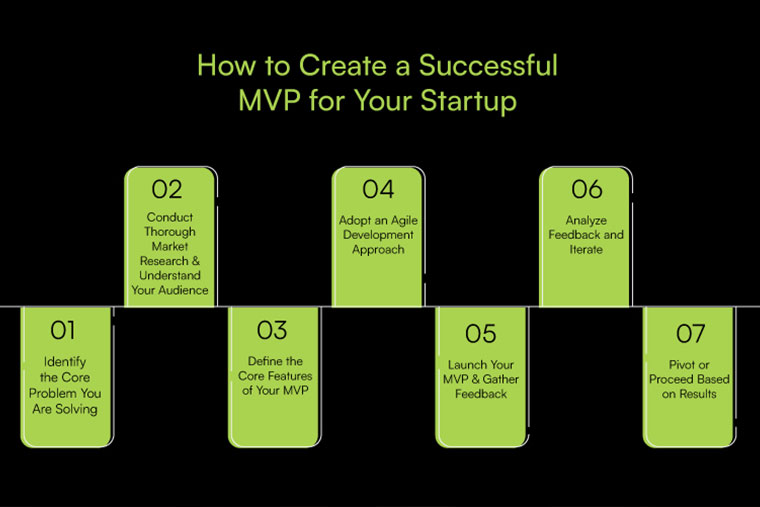Introduction
Starting a new business or launching a product is an exhilarating journey, but it comes with inherent risks, especially when it comes to product development. Many startups invest considerable time, effort, and capital into building a product that ultimately fails to meet market needs. So how can startups avoid this costly mistake and ensure their product idea resonates with their target audience? The answer lies in creating a Minimum Viable Product (MVP).
An MVP is the first version of your product that includes just enough features to test your core assumptions and solve the primary problem of your target users. It’s designed to gather user feedback, validate your product-market fit, and allow you to make data-driven decisions before committing to full-scale development. Developing a successful MVP is crucial for startups, as it allows them to test their product ideas with minimal resources and reduce the risk of failure.
In this detailed guide, we’ll walk you through the essential steps to create a successful MVP for your startup, from identifying your problem and target audience to gathering feedback, iterating, and scaling your product. Whether you’re building a mobile app, SaaS solution, or consumer product, this guide will provide you with the tools to effectively validate your product idea and set your startup up for success.
What is an MVP and Why is it Crucial for Startups?

Before diving into the steps of MVP development, it’s important to understand what an MVP is and why it’s especially beneficial for startups.
A Minimum Viable Product (MVP) is a simplified version of your product that contains only the core features necessary to address the primary pain points of your target audience. The goal of the MVP is not to create a polished, fully-featured product; instead, it's to test the core assumptions behind your product idea and to validate whether there is a market for it.
For startups, the MVP approach is incredibly valuable because:
- Cost Efficiency: Building a full product can be costly. An MVP allows you to test your product with the bare minimum investment, saving both time and resources.
- Market Validation: You can test the product-market fit by releasing a basic version to real users, helping you understand if your idea has traction before investing further.
- Speed to Market: An MVP allows you to get your product out to the market quickly, enabling you to gather feedback from real users, faster.
- Learning and Iteration: An MVP isn’t the end of the road; it’s a tool for learning. By gathering feedback, you can improve your product and refine it based on real-world use, instead of making assumptions about what your users need.
For example, instead of spending years developing a fully-featured app, you can create an MVP with just the core functionality, test it with real users, and iterate based on feedback. This approach helps startups avoid building a product that doesn’t meet the actual needs of their target market.
How to Create a Successful MVP for Your Startup

Step 1: Identify the Core Problem You Are Solving
Every successful product addresses a specific problem. The first step in building a successful MVP is to clearly identify the core problem that your product will solve. This problem should be important to your target audience and must be a pain point they are actively seeking solutions for.
Key Questions to Consider:
- What problem are you solving, and why is it important?
- Who is experiencing this problem? (Target audience demographics and psychographics)
- How is this problem currently being solved, and why is your solution better?
For example, if you're building a fitness app, the problem you might be solving could be that users find it difficult to track their workouts and progress without a simple, unified tool. By identifying this core problem, you’ll be able to design a product that directly addresses this need.
Step 2: Conduct Thorough Market Research and Understand Your Audience
Market research is a crucial step in the MVP development process, especially for startups. Understanding your target audience and their specific needs is vital to ensure that your MVP solves a real problem. Conducting in-depth research helps you gain insights into your customers' behaviors, preferences, and pain points.
Research Methods:
- Surveys and Interviews: Conduct surveys and one-on-one interviews with potential users to gain a deeper understanding of their needs, frustrations, and desires. This research will allow you to create a more focused MVP.
- Competitor Analysis: Look at existing products or solutions that serve the same audience. What are they doing well? What are they lacking? Understanding your competitors can help you identify gaps in the market and differentiate your MVP.
- User Personas: Develop detailed user personas to understand who your target users are. These personas should include information about their job roles, lifestyle, goals, challenges, and preferred solutions.
This research helps ensure that your MVP resonates with real users and addresses their specific pain points, rather than relying on assumptions.
Step 3: Define the Core Features of Your MVP
Once you’ve identified the problem and your target audience, the next step is to define the core features of your MVP. The key here is to focus on the features that are absolutely necessary – must have to address the core problem you’ve identified, and nice to have - features that will add value.
Best Practices:
- Prioritize Core Features: Include only the features that are essential for solving the problem. These should be the features that allow users to engage with the product meaningfully. Avoid adding any extra functionalities that are not necessary at this stage.
- Simplicity Over Complexity: Your MVP should be simple but functional. The goal is to test your core assumptions, not to create a fully-featured product.
- User Experience: While your MVP doesn’t need to be perfect, it should still offer a seamless user experience. An intuitive interface and basic functionality are important for retaining early users.
For instance, if you’re building a ride-sharing app, the MVP might focus on key features such as user registration, ride booking, and payment processing, leaving out more advanced features like ride ratings or driver tracking.
Step 4: Adopt an Agile Development Approach
The MVP development process should be iterative and flexible. Using an agile development methodology allows you to build your MVP in short cycles (sprints), gather feedback, and make improvements quickly.
Benefits of Agile:
- Iterative release cycle: Agile development focuses on completing small, incremental tasks that contribute to the overall product. This allows you to release early and gather feedback.
- Quick Feedback: Agile enables you to adjust the MVP based on feedback without having to overhaul the entire product.
- Stakeholder Collaboration: Agile promotes collaboration between teams—product owner, development, testing and marketing—ensuring that everyone is aligned with the product goals.
The MVP should be developed and tested in short, manageable sprints, ensuring that the product evolves based on real-world feedback.
Step 5: Launch Your MVP and Gather Feedback
Once your MVP is ready, it’s time to launch it and get feedback from real users. The goal is to validate whether your product solves the problem and resonates with users.
Ways to Launch Your MVP:
- Beta Testing: Release the MVP to a small group of users who are willing to provide feedback. These users should represent your target audience and be able to give you insights into usability, functionality, and value.
- Landing Page: If you’re developing a digital product, create a landing page that highlights the MVP’s key features. Use the landing page to gauge interest and attract potential customers.
- Social Media and Influencer Outreach: Leverage your network and online communities to promote your MVP. You can also use social media platforms to reach out to your target audience and generate early interest.
At this stage, the goal isn’t to have a perfect product; it’s to gather data from real users that will help guide the next steps of development.
Step 6: Analyze Feedback and Iterate
After gathering feedback, it’s crucial to analyze the data and use it to iterate on your MVP. Continuous iteration is key to refining the product and improving its value.
Feedback Collection:
- Surveys: Ask users about their experience with the MVP, what they liked, what they didn’t, and what improvements they suggest.
- User Analytics: Use analytics tools like Google Analytics or Mixpanel to track how users are interacting with the MVP. Are they completing key actions? Where are they dropping off?
- Usability Testing: Conduct usability tests to observe how users interact with the product in real-time.
Based on this feedback, prioritize the most impactful changes and implement them in the next iteration.
Step 7: Pivot or Proceed Based on Results
Once the feedback is analyzed, you’ll need to decide whether to pivot or proceed. Here’s how to determine the best course of action:
- Pivot: If the feedback shows that your MVP isn’t meeting the market’s needs, or if the demand isn’t strong enough, it may be time to pivot. This could involve changing your target audience, refining the core functionality, or altering the value proposition.
- Proceed: If the feedback is positive and users are engaged, it’s time to proceed with further development. Continue to add features based on the feedback you’ve gathered and focus on scaling the product.
Conclusion

Building a successful MVP is crucial for startups to validate their ideas, gather real-world feedback, and ensure that their product meets market demand. By focusing on the core problem, understanding the audience, and prioritizing essential features, you can create an MVP that not only solves a real problem but also provides a solid foundation for future growth.
At Cabot Technology Solutions, we specialize in helping startups build MVPs that are both lean and scalable. Our team of experts works closely with you to create a product that is user-friendly, solves real customer pain points, and is ready for further iteration based on user feedback. Get in touch with us today to learn how we can help you create a successful MVP for your startup.

